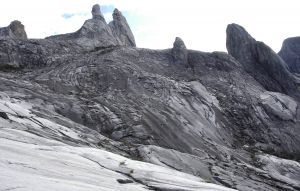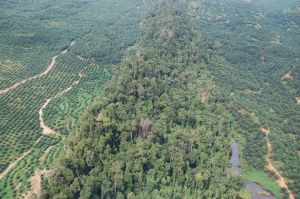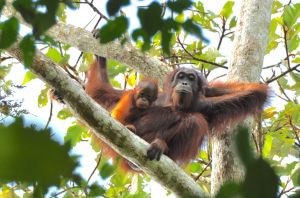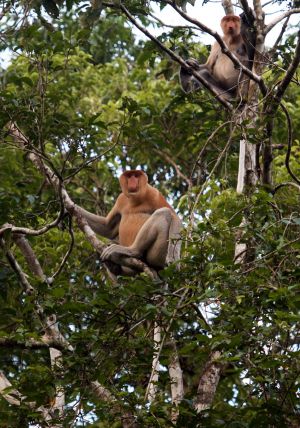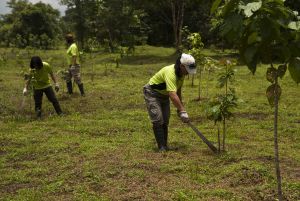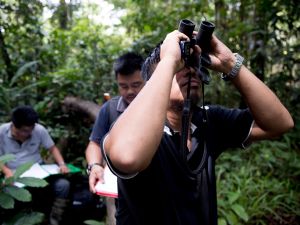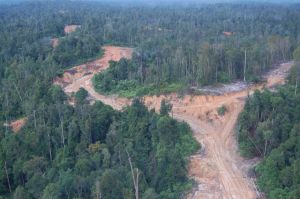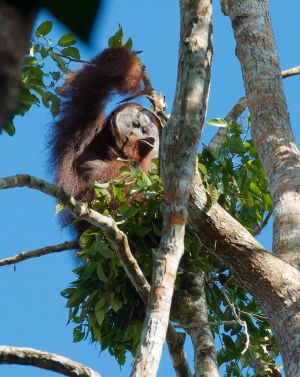Difference between revisions of "Sabah"
| (29 intermediate revisions by the same user not shown) | |||
| Line 17: | Line 17: | ||
* Conservation activities have focused on orangutan rehabilitation, canopy bridges, involvement of local people in conservation activities, habitat restoration, and capacity building. | * Conservation activities have focused on orangutan rehabilitation, canopy bridges, involvement of local people in conservation activities, habitat restoration, and capacity building. | ||
<div><ul> | <div><ul> | ||
| − | <li style="display: inline-block;">[[File:sc_Kinabalu_rocks_HUTAN.jpg | 300px | thumb| right | © HUTAN]] | + | <li style="display: inline-block;">[[File:sc_Kinabalu_rocks_HUTAN.jpg | 300px | thumb| right |Kinabalu © HUTAN/KOCP]] |
| − | <li style="display: inline-block;"> [[File: | + | <li style="display: inline-block;"> [[File: sc_forest_patch_HUTAN.jpg | 300px | thumb| right | © HUTAN/KOCP]] |
| − | <li style="display: inline-block;">[[File: Res orangutan HUTAN.JPG.JPG | 300px | thumb| right | © HUTAN]] | + | <li style="display: inline-block;">[[File: Res orangutan HUTAN.JPG.JPG | 300px | thumb| right | © HUTAN/KOCP]] |
</ul></div> | </ul></div> | ||
= Site characteristics = <!-- A paragraph summary of physical and geographic aspects of the site, and a table of key information --> | = Site characteristics = <!-- A paragraph summary of physical and geographic aspects of the site, and a table of key information --> | ||
| − | + | [[File: Sc Proboscis HUTAN.jpg | 300px | thumb| right | Proboscis monkey © HUTAN/KOCP]] | |
Sabah is one of the 13 states in Malaysia, situated in the north of Borneo. The state covers about 76,000 sq. km. The state features the highest mountain in Malaysia, Mount Kinabalu, at 4,095 m. About 16% of Sabah's total forest area is under some form of protection (Butler 2020). Mangrove forests are found largely on the east coast facing the Sulu Sulawesi Seas. Sabah harbours a wide diversity of wildlife, including 221 recorded species of mammals, 98 of amphibians, 197 of reptiles, 664 of birds, and thousands of invertebrate species (Mannan et al. 2013). In addition to orangutans, proboscis monkey, tembadau, rhinoceros and pygmy elephant are also present in Sabah (Mannan et al. 2013). | Sabah is one of the 13 states in Malaysia, situated in the north of Borneo. The state covers about 76,000 sq. km. The state features the highest mountain in Malaysia, Mount Kinabalu, at 4,095 m. About 16% of Sabah's total forest area is under some form of protection (Butler 2020). Mangrove forests are found largely on the east coast facing the Sulu Sulawesi Seas. Sabah harbours a wide diversity of wildlife, including 221 recorded species of mammals, 98 of amphibians, 197 of reptiles, 664 of birds, and thousands of invertebrate species (Mannan et al. 2013). In addition to orangutans, proboscis monkey, tembadau, rhinoceros and pygmy elephant are also present in Sabah (Mannan et al. 2013). | ||
| Line 38: | Line 38: | ||
|- | |- | ||
|Habitat types <!-- List IUCN Habitat Classification 3.0 categories present (without number), see link below --> | |Habitat types <!-- List IUCN Habitat Classification 3.0 categories present (without number), see link below --> | ||
| − | |Subtropical/tropical moist lowland forest, subtropical/tropical moist montane forest, subtropical/tropical heavily degraded former forest, subtropical/tropical mangrove vegetation above high tide level, plantations, urban areas | + | |Subtropical/tropical moist lowland forest, subtropical/tropical moist montane forest, rocky areas (e.g., inland cliffs, mountain peaks), subtropical/tropical heavily degraded former forest, subtropical/tropical mangrove vegetation above high tide level, plantations, urban areas |
|} | |} | ||
[https://www.iucnredlist.org/resources/habitat-classification-scheme IUCN habitat categories] [[Site designations]] | [https://www.iucnredlist.org/resources/habitat-classification-scheme IUCN habitat categories] [[Site designations]] | ||
| Line 192: | Line 192: | ||
Almost half of Sabah's landmass has been gazetted as Permanent Forest Reserve (PFR), which encompasses 3.54 million ha, of which 1.61 million ha are protected forests, and the remaining 1.93 million are production forests (Simon et al. 2019). In addition to the PFR, state parks, wildlife sanctuaries and conservation areas add another 0.27 million ha of protected forests (Simon et al. 2019). In 1998, with support from the Sabah Wildlife Department, [https://www.hutan.org.my/our-work/orang-utans/ HUTAN] established the Kinabatangan Orang-utan Conservation Programme (or KOCP) in the village of Sukau. The 2020-2029 Orangutan Action Plan for Sabah highlights the following objectives and actions to be implemented in the region: halting habitat loss and restore habitat, ensure better protection of orangutans (e.g., more effective law enforcement), ensure survival of orangutans in agricultural landscapes, improve ex-situ practises (e.g., rehabilitation of individuals), and monitor and predict population trends (SWD 2020). | Almost half of Sabah's landmass has been gazetted as Permanent Forest Reserve (PFR), which encompasses 3.54 million ha, of which 1.61 million ha are protected forests, and the remaining 1.93 million are production forests (Simon et al. 2019). In addition to the PFR, state parks, wildlife sanctuaries and conservation areas add another 0.27 million ha of protected forests (Simon et al. 2019). In 1998, with support from the Sabah Wildlife Department, [https://www.hutan.org.my/our-work/orang-utans/ HUTAN] established the Kinabatangan Orang-utan Conservation Programme (or KOCP) in the village of Sukau. The 2020-2029 Orangutan Action Plan for Sabah highlights the following objectives and actions to be implemented in the region: halting habitat loss and restore habitat, ensure better protection of orangutans (e.g., more effective law enforcement), ensure survival of orangutans in agricultural landscapes, improve ex-situ practises (e.g., rehabilitation of individuals), and monitor and predict population trends (SWD 2020). | ||
| − | + | <div><ul> | |
| + | <li style="display: inline-block;">[[File: cons_Reforestation2_HUTAN.jpg | 300px | thumb| right |Reforestation © HUTAN/KOCP]] | ||
| + | <li style="display: inline-block;"> [[File: Cons reforestation team HUTAN (2).jpg | 300px | thumb| right |Reforestation team © HUTAN/KOCP]] | ||
| + | <li style="display: inline-block;">[[File: Res observe hutan2.jpg | 300px | thumb| right | © HUTAN/KOCP]] | ||
| + | </ul></div> | ||
'''Table 4. Conservation activities in Sabah''' | '''Table 4. Conservation activities in Sabah''' | ||
{| border="1" cellpadding="5" cellspacing="0" class="conservation-actions-table" | {| border="1" cellpadding="5" cellspacing="0" class="conservation-actions-table" | ||
| Line 282: | Line 286: | ||
|} | |} | ||
[[Conservation activities list (Junker et al. 2017)]] | [[Conservation activities list (Junker et al. 2017)]] | ||
| − | + | [[File: Threats roads HUTAN.jpg | 300px | thumb| right | © HUTAN/KOCP]] | |
= Challenges = <!-- Overview of challenges in ape conservation --> | = Challenges = <!-- Overview of challenges in ape conservation --> | ||
| Line 296: | Line 300: | ||
= Research activities = <!-- Overview of research activities --> | = Research activities = <!-- Overview of research activities --> | ||
| − | + | [[File: as_orangutan1_HUTAN.jpg | 300px | thumb| right | © HUTAN/KOCP]] | |
| − | Research activities have been mainly focused on surveys and biomonitoring, studies on orangutan ecology in disturbed forest as well as agricultural landscapes, genetic studies, and in the past, rehabilitation/post release monitoring. Based on the results of the surveys undertaken by HUTAN and the Sabah Wildlife Department, the government increased the size of areas under protection in the state from about 12% of the land-mass in the early 2000s to 26% today. The ultimate goal of the government is to fully protect 30% of Sabah's land-mass. Currently, more than 80% of the current orang-utan population found in Sabah occurs in fully protected forests (https://www.hutan.org.my/our-work/orang-utans/ HUTAN ). | + | Research activities have been mainly focused on surveys and biomonitoring, studies on orangutan ecology in disturbed forest as well as agricultural landscapes, genetic studies, and in the past, rehabilitation/post release monitoring. Based on the results of the surveys undertaken by HUTAN and the Sabah Wildlife Department, the government increased the size of areas under protection in the state from about 12% of the land-mass in the early 2000s to 26% today. The ultimate goal of the government is to fully protect 30% of Sabah's land-mass. Currently, more than 80% of the current orang-utan population found in Sabah occurs in fully protected forests ([https://www.hutan.org.my/our-work/orang-utans/ HUTAN]). |
For a full list of research articles visit https://www.hutan.org.my/research-articles/ | For a full list of research articles visit https://www.hutan.org.my/research-articles/ | ||
| Line 331: | Line 335: | ||
<br> | <br> | ||
| − | '''Page completed by: '''A.P.E.S. Wiki team''' Date:'''08/12/2021 <!-- If you don't want to add your name, you can add "A.P.E.S. Wiki team" --> | + | '''Page completed by: '''Marc Ancrenaz & A.P.E.S. Wiki team''' Date:'''08/12/2021 <!-- If you don't want to add your name, you can add "A.P.E.S. Wiki team" --> |
Latest revision as of 03:24, 10 December 2021
Summary
- Northeast Bornean orangutans (Pongo pygmaeus morio) are present in Sabah.
- It has been estimated that 9,558 (CI: 6,815-15,129) individuals occur in the site.
- The orangutan population trend is decreasing.
- The site has a total size of 76,000 km².
- Key threats to orangutans are forest conversion and fragmentation.
- Conservation activities have focused on orangutan rehabilitation, canopy bridges, involvement of local people in conservation activities, habitat restoration, and capacity building.
Site characteristics
Sabah is one of the 13 states in Malaysia, situated in the north of Borneo. The state covers about 76,000 sq. km. The state features the highest mountain in Malaysia, Mount Kinabalu, at 4,095 m. About 16% of Sabah's total forest area is under some form of protection (Butler 2020). Mangrove forests are found largely on the east coast facing the Sulu Sulawesi Seas. Sabah harbours a wide diversity of wildlife, including 221 recorded species of mammals, 98 of amphibians, 197 of reptiles, 664 of birds, and thousands of invertebrate species (Mannan et al. 2013). In addition to orangutans, proboscis monkey, tembadau, rhinoceros and pygmy elephant are also present in Sabah (Mannan et al. 2013).
Table 1. Basic site information for Sabah
| Area | 76,000 km² |
| Coordinates | 5.212839 N, 116.996555 E |
| Designation | Unclassified |
| Habitat types | Subtropical/tropical moist lowland forest, subtropical/tropical moist montane forest, rocky areas (e.g., inland cliffs, mountain peaks), subtropical/tropical heavily degraded former forest, subtropical/tropical mangrove vegetation above high tide level, plantations, urban areas |
IUCN habitat categories Site designations
Ape status
In the early 1980s, WWF-Malaysia estimated 4,000 orangutans in 5,000 sq. km. of Sabah’s primary forest in the eastern lowlands and central uplands. In the mid-1980s, the first aerial nest surveys were conducted; combined with habitat assessments, it was estimated that up to 21,000 orangutans inhabited Sabah´s forest reserves and state parks (Simon et al. 2019). Fifteen years later, in 2002-2003, an aerial and ground nest survey identified 16 major orangutan populations in Sabah with a total 11,000 individuals (Ancrenaz et al. 2005). The most recent aerial survey that followed, between 2014 and 2017, estimated 9,558 orangutans (95% CI: 6,815 to 15,129), with separate studies recording a further 800 orangutans in the Lower Kinabatangan region. This results in a conservative population estimate of 10,300 orangutans in Sabah’s Permanent Forest Reserve and wildlife sanctuary (Simon et al. 2019).
Table 2. Ape population estimates in Sabah
| Species | Year | Abundance estimate (95% CI) | Density estimate [ind./ km²] (95% CI) | Encounter rate (nests/km) | Area | Method | Source | Comments | A.P.E.S. database ID |
|---|---|---|---|---|---|---|---|---|---|
| Pongo pygmaeus morio | 2002-2003 | 11,017 (8,317-18,376) | Sabah | Aerial survey and line transects | Ancrenaz et al. 2005 | ||||
| Pongo pygmaeus morio | 2014-2017 | 9,558 (6,815-15,129) | Sabah, 63% of the previously surveyed areas (in 2002-2003). | Aerial survey | Simon et al. 2019 |
Threats
Forest conversion and fragmentation are the key threats to orangutans in Sabah (Wich et al. 2008). Between 1973 and 2010, 39% of rainforests were lost in Borneo, including more than 98,000 sq. km of suitable orangutan habitat (Simon et al. 2019). Specifically, conversion of natural habitat to oil palm and tree plantations is a major threat (Simon et al. 2019).
Table 3. Threats to apes in Sabah
| Category | Specific threats | Threat level | Quantified severity | Description | Year of threat |
|---|---|---|---|---|---|
| 1. Residential & commercial development | Unknown | ||||
| 2. Agriculture & aquaculture | 2.1 Annual & perennial non-timber crops | High | Deforestation for agriculture (Wich et al. 2008; Simon et al. 2019). | Ongoing (2019) | |
| 3. Energy production & mining | Absent | ||||
| 4. Transportation & service corridors | 4.1 Roads & railroads | High | Construction of the Pan Borneo highway is increasing forest fragmentation and opening up forested areas for resource extraction (Tian Tong 2021). | Ongoing (2021) | |
| 5. Biological resource use | 5.1 Hunting & collecting terrestrial animals | Present, but threat severity is unknown | Hunting pressure, either for meat or human-orangutan conflict situations (Simon et al. 2019). | Ongoing (2019) | |
| 5.3 Logging & wood harvesting | High | Timber extraction (Wich et al. 2008; Simon et al. 2019). | Ongoing (2019) | ||
| 6. Human intrusion & disturbance | Unknown | ||||
| 7. Natural system modifications | Unknown | ||||
| 8. Invasive & other problematic species, genes, diseases | Unknown | ||||
| 9. Pollution | Unknown | ||||
| 10. Geological Events | Absent | ||||
| 11. Climate change & severe weather | 11.1 Habitat shifting & alteration | Present, but threat severity is unknown | Impacts of climate change are likely to reduce suitable orangutan habitat (Simon et al. 2019). | Ongoing (2019) | |
| 12. Other options | 12.1 Other threat | High | Forest fragmentation is the main threat to orangutans in Sabah (SWD 2020). | Ongoing (2020) |
Conservation activities
Almost half of Sabah's landmass has been gazetted as Permanent Forest Reserve (PFR), which encompasses 3.54 million ha, of which 1.61 million ha are protected forests, and the remaining 1.93 million are production forests (Simon et al. 2019). In addition to the PFR, state parks, wildlife sanctuaries and conservation areas add another 0.27 million ha of protected forests (Simon et al. 2019). In 1998, with support from the Sabah Wildlife Department, HUTAN established the Kinabatangan Orang-utan Conservation Programme (or KOCP) in the village of Sukau. The 2020-2029 Orangutan Action Plan for Sabah highlights the following objectives and actions to be implemented in the region: halting habitat loss and restore habitat, ensure better protection of orangutans (e.g., more effective law enforcement), ensure survival of orangutans in agricultural landscapes, improve ex-situ practises (e.g., rehabilitation of individuals), and monitor and predict population trends (SWD 2020).
Table 4. Conservation activities in Sabah
| Category | Specific activity | Description | Year of activity |
|---|---|---|---|
| 1. Residential & commercial development | Not reported | ||
| 2. Agriculture & aquaculture | Not reported | ||
| 3. Energy production & mining | Not reported | ||
| 4. Transportation & service corridors | 4.2. Install rope or pole (canopy) bridges | HUTAN install orangutan bridges. | Ongoing (2021) |
| 5. Biological resource use | 5.16. Implement community control of patrolling, banning hunting and removing snares | In 2002, the Sabah Wildlife Department trained and appointed people from the Kinabatangan community to become “Honorary Wildlife Wardens” or HWWs. HWWs are civilians who are given the same legal powers as rangers from the Sabah Wildlife Department to conserve and manage the natural resources of the State and to apprehend offenders when necessary (HUTAN). | Ongoing (2021) |
| 6. Human intrusion & disturbance | Not reported | ||
| 7. Natural system modifications | Not reported | ||
| 8. Invasive & other problematic species, genes, diseases | Not reported | ||
| 9. Pollution | Not reported | ||
| 10. Education & Awareness | 10.1. Educate local communities about primates and sustainable use | The Sabah Environmental Education Network (SEEN) is a network of people and NGOs working together to implement environmental education programmes and activities in Sabah (Sabah SEEN). The HUTAN Environmental and Awareness Program (HEAP) offers high-quality free environmental education programmes (sanctioned by the Sabah Education Department) to primary and secondary schools throughout Sabah (HUTAN). | Ongoing (2021) |
| 11. Habitat Protection | 11.2. Legally protect primate habitat | More than 80% of the current orangutan population in Sabah occurs in fully protected forests (HUTAN). | Ongoing |
| 11.7. Restore habitat corridors | Habitat restoration to link isolated populations (HUTAN). | Ongoing (2021) | |
| 12. Species Management | 12.24. Rehabilitate injured/orphaned primates | Sepilok Orangutan Rehabilitation Centre is located in Sabah. Established in 1964, the centre provides medical care for orphaned and confiscated orangutans. | Ongoing |
| 13. Livelihood; Economic & Other Incentives | Not reported | ||
| 14. Other | Engagement of the private sector and their management of orangutans outside protected forests (HUTAN). | Ongoing (2021) | |
| 14. Other | HUTAN has created a training platform to enhance capacity for both government and non-government staff in such areas as biodiversity monitoring, management and protection, research methodologies, mapping and remote sensing, education and awareness techniques, and community engagement (HUTAN). | Ongoing (2021) |
Conservation activities list (Junker et al. 2017)
Challenges
Table 5. Challenges reported for Sabah
| Challenge | Source |
|---|---|
| Not reported |
Research activities
Research activities have been mainly focused on surveys and biomonitoring, studies on orangutan ecology in disturbed forest as well as agricultural landscapes, genetic studies, and in the past, rehabilitation/post release monitoring. Based on the results of the surveys undertaken by HUTAN and the Sabah Wildlife Department, the government increased the size of areas under protection in the state from about 12% of the land-mass in the early 2000s to 26% today. The ultimate goal of the government is to fully protect 30% of Sabah's land-mass. Currently, more than 80% of the current orang-utan population found in Sabah occurs in fully protected forests (HUTAN).
For a full list of research articles visit https://www.hutan.org.my/research-articles/
Documented behaviours
Table 6. Ape behaviors reported for Sabah
| Behavior | Source |
|---|---|
| Not reported |
External links
Sepilok Orangutan Rehabilitation Center
Hutan-Kinabatangan Orangutan Conservation Programme
HUTAN
Relevant datasets
References
Ancrenaz M, Gimenez O, Ambu L, Ancrenaz K, Andau P, Goossens B, et al. (2005) Aerial Surveys Give New Estimates for Orangutans in Sabah, Malaysia. PLoS Biol 3(1): e3. https://doi.org/10.1371/journal.pbio.0030003
Buttler, R.A (29 June, 2020). Borneo. Mongabay. https://rainforests.mongabay.com/borneo/
Mannan, S., Lee, Y.F., Kugan, F., Ong, R.C. & Chung, A.Y.C. (2013). Wealth creation from biodiversity conservation: the Sabah way. Paper presented at the International Conference on Challenges of Extended Mega Urban Regions: the Challenging Face of South East Asia and the World. 19-21 November, 2013, Putrajaya, Malaysia.
Sabah Wildlife Department (2020). Orangutan Action Plan for Sabah 2020-2029. Kota Kibanalu, Sabah, Malaysia.
Simon D, Davies G, Ancrenaz M (2019) Changes to Sabah’s orangutan population in recent times: 2002–2017. PLoS ONE 14(7): e0218819. https://doi.org/10.1371/journal.pone.0218819
Tian Tong, S.L. (13 August, 2021). Highway cutting through Heart of Borneo poised to be ‘very, very bad’. Mongabay. Online: https://news.mongabay.com/2021/08/highway-cutting-through-heart-of-borneo-poised-to-be-very-very-bad/
Wich, S., Meijaard, E., Marshall, A., Husson, S., Ancrenaz, M., Lacy, R., . . . Singleton, I. (2008). Distribution and conservation status of the orang-utan (Pongo spp.) on Borneo and Sumatra: How many remain? Oryx, 42(3), 329-339. doi:10.1017/S003060530800197X
Page completed by: Marc Ancrenaz & A.P.E.S. Wiki team Date:08/12/2021
